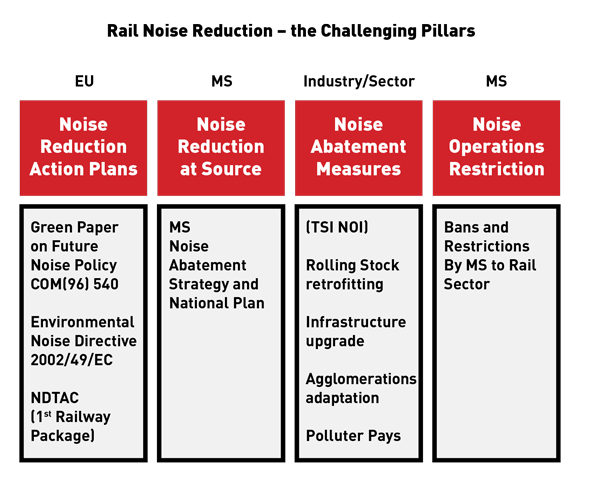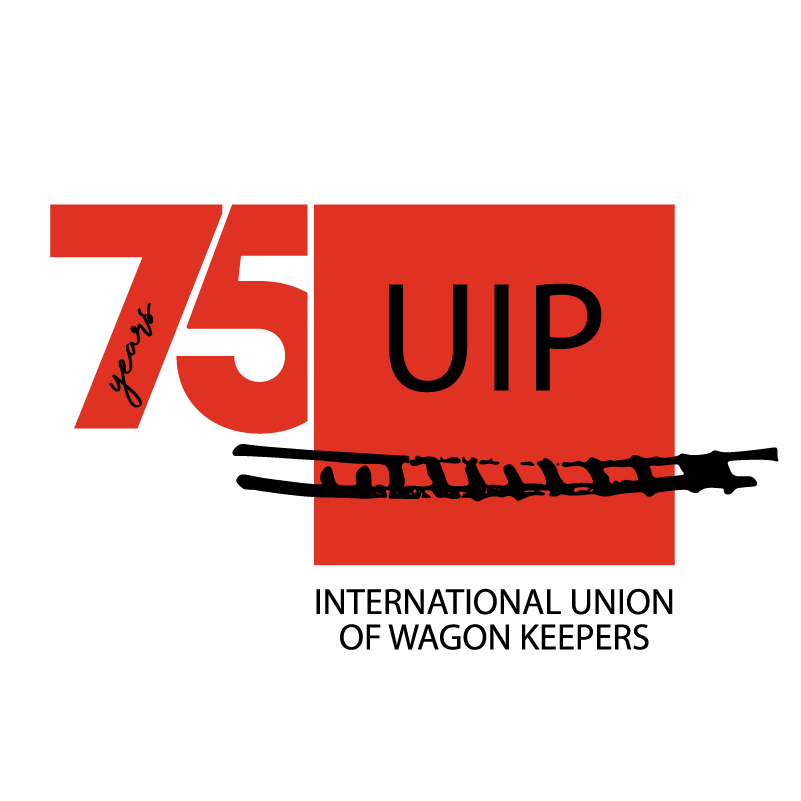Noise
Railway noise reduction raises to the next level
UIP and its members recognise that noise is a critical environmental burden that affects not only society, but also the performance of the railway system around Europe. The EU has already taken a number of measures towards noise reduction. However, noise is proving to be a complex topic that requires sound cost-efficient measures and action plans that need to reflect the political and economic priorities of the national governments, while at the same time maintain the performance and competitiveness of the railway system.

Significance to UIP and our Members
Any existing and forthcoming EU legislation on noise reduction has an impact on transaction, operational and maintenance costs for the rail freight sector, particularly the Wagon Keepers who are expected to invest a great deal in the retrofitting of their fleet. UIP fully supports the objective of reducing rail freight noise and understands the need to increase the pace towards having only TSI noise compliant wagons (retrofitted or new builds) running throughout Europe. However, as only few Member States are considering concrete measures for noise reduction, UIP warns about an increasing risk for unbalanced implementation of noise reduction strategies at national level which will further jeopardise rail freight competitiveness and efficient cross border traffic.
UIP focuses its activities on supporting the European Commission towards developing an appropriate Noise Abatement Strategy that could lead to a harmonised implementation across Europe. Since the first CEF call for actions to reduce rail freight noise was launched between October 2016 and February 2017, CEF has so far co-funded the retrofitting of more than 120,000 rail freight wagons with the objective to reduce noise emissions with a contribution of over EUR 27 million. Nevertheless, the Commission estimated that approximately 134,619 S- and 5,235 SS-wagons still had to be retrofitted in the EU. This is why, on 8th January 2019 a new CEF call opened with an indicative funding of €35 million for reducing rail freight noise by retrofitting existing freight wagons with composite brake blocks, and where necessary due to extreme weather conditions with disc brakes, including by retrofitting of existing rolling stock (submission deadline was 24th April 2019).
One of the achievements UIP had advocated for was that for the first time the CEF contribution took the form of unit contribution which simplified the application process and ensures certainty and transparency in the funding levels. In addition, reporting requirements had been reduced as no certification or financial statement needed to be provided by the beneficiaries and no Cost-Benefit Analysis (CBA) was needed. UIP members built two consortia in order to reach the minimum threshold of 2,000 wagons and participated in the call. The overarching goal behind this is that the whole European wagon fleet, organised within UIP, becomes fully retrofitted and thereby TSI NOISE-compliant. According to current predictions, by 2023 this will be the achieved for 89% of the private wagon fleet. UIP supports the continuation of the topic noise under the CEF 2021-27 budget in order to allow for a broad market deployment of economically feasible research results.
In May 2016, UIP joined the European Railway Agency Task Force for the revision of the Noise TSI. The revised TSI NOISE text, adopted at the 84th Railway Interoperability and Safety Committee (RISC) in January 2019, introduced the so-called “quieter routes approach” (entry into force in December 2024). These routes are to be defined as “quiet” if at least 12 freight trains are operated on them per night. While the Swedish and the Finish networks are exempted from this approach until the end of 2032, the Commission was tasked with issuing a report on the use of Composite Brake Blocks (CBBs) in heavy winter conditions until June 2020. This work should assess the size of the reported lack of braking performance and find solutions, which may include technical, legal or operational elements. It is still unclear how the Swedish authorities will deal with this on their rail network from 2020 and how the Swedish authorities will react to the operation of foreign quiet and LL-converted freight wagons on their network.
In contradiction to this quieter routes approach laid down in the revised TSI NOISE, different national deadlines for the modification of noisy wagons exist within Switzerland (2020) and Germany (2021). This in turn means that special legal regimes only exist in some regions of Europe to the detriment of the objective of promoting and increasing rail freight market shares in Europe and addressing the challenges of climate change.
In March 2019, UIP contributed to the evaluation of Implementing Regulation (EU) No 2015/429, the legal basis for noise differentiated track access charges (NDTAC) schemes. NDTAC schemes are currently only applied in Germany, Austria and the Netherlands. Consequently, the NDTAC Regulation has not proven effective in reducing railway noise directly throughout Europe. The major barrier to wagon keepers’ ability to retrofit is not only the one-off costs of retrofitting but also the ensuing higher operating costs caused by an increased wear and tear. Against this background, NDTAC itself only represents a minimal financial contribution to countering these rising costs as very few countries have implemented such a scheme. Furthermore, while the NDTAC scheme incentivises primarily Railways Undertakings as they receive the bonus if they use TSI Noise compliant wagons in their trains, the costs are on the wagon keepers. According to recital 14 of the NDTAC regulation, the incentives should be passed on to those who bear the costs of retrofitting, namely the keepers. Despite this idea, the passing on of the bonuses currently relies solely on the willingness of Railway Undertakings to enter private contractual relations with the keeper(s). As a result, the bonuses are often not or not fully passed on, as is currently the case in DE and AT. Therefore, we expressed our believe that the effectiveness of current schemes as well as the successful application of NDTAC‐schemes in more EU Member States (MS) can be increased, which is why we recommended to:
- Significantly increase the level of bonuses paid under NDTAC schemes in the EU to truly incentivise the retrofitting of wagons
- Establish a functioning and mandatory mechanism allowing for the passing on of bonuses to those rail actors bearing the costs ‐the wagon keepers
- Continue to compensate beyond 2021 the one‐off costs of retrofitting and the higher maintenance costs for retrofitted wagons due to additional wear and tear through NDTAC as incentive scheme complementing the direct funding, such as CEF and national programmes
In October 2018, the new WHO Environmental Noise Guidelines for the European Region have been published entailing a strong recommendation to reduce railway noise to under 54dB Lday and 44 Lnight. These noise limits are purely based on the empirical studies on the noise impact on health and therefore still require a sound impact assessment of feasibility and costs before they can build the ground for political decisions. In addition, a revision of Annex 3 of the Directive 2002/49 relating to the assessment and management of environmental noise is planned for 2019. It is to be accompanied by a public consultation and the Member States will be asked to quantify the noise effects on public health and develop national action plans accordingly. Against this background, UIP recommends taking the positive developments of wagon retrofitting since 2016 into account and reminds that noise is not only a problem of the subsystem wagon but that solutions also must be found at the level of locomotives and railway infrastructure. In any case, innovation will be the key element of further noise abatement measure that will certainly leads to even quieter newly built rail freight wagons.

